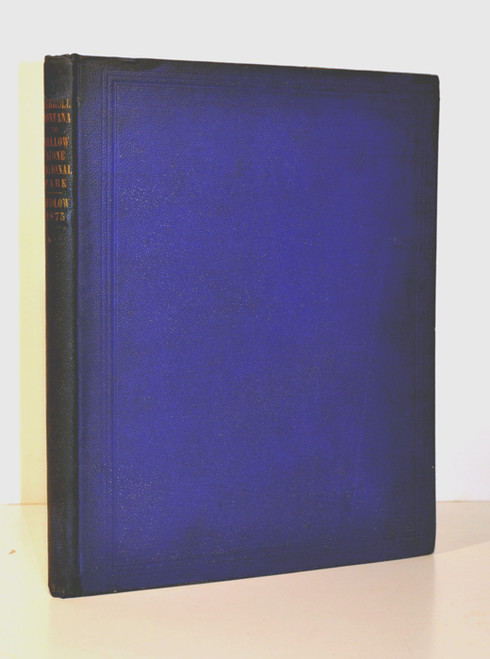Peale, Albert Charles; The Thermal Springs of Yellowstone National Park. AUTHOR’S EDITION. Washington, June 13, 1883. Large octavo, pp. title, 65-454, colored frontispiece, plate C, D, I, ia, ii-iv, v-vd, vi-vid, vii-xi, xia, xii-xiii, xiiiia, xiv, xiva, xv-xviii, xix, xixa, xx-xxxii, xxxiia, xxxiii, xxxiiia, xxxiv-xl, xla, xlb, xlia, xlii-xlv, figures 1-32, 11 maps (most folded).
This rare Author’s edition offprint of the thermal springs report which forms the bulk of Hayden’s 12th Annual Report, part 2. The report retains the original soft title cover and is bound in a later cloth with gilt spine title’s, marbled end papers and marbled text block edges. Owner’s private book plate on paste down. The binding is tight and clean with bright titles. The text is clean, small penned number on title cover, the largest four of the folding maps were repacked with archival tissue to preserve them. Those maps were brittle due to a poorer quality paper. Those four maps are now in a separate sleeve. The remaining plates and maps are clean with minor edge toning. A very rare copy of a special printing of the first major work on Yellowstone and its thermal springs.
Albert Charles Peale (1849-1914) was a geologist, mineralogist, and paleobotanist. From 1871 through 1879, served as the mineralogist and geologist with Hayden’s United States Geological and Geographical Survey of the Territories studying lands in the territories of Idaho, Wyoming and Montana. Peale came from a long lineage of naturalists and natural scientists.
Three generations of Peales had been involved in scientific discoveries in 19th century America. His great-grandfather, Charles Willson Peale, was a prominent
naturalist and a leading popularizer of science In the United States in the first years of the1800s. He was the founder of a famous Philadelphia museum of natural history, a distinguished member of the American Philosophical Society and played a role in the scientific studies of the Lewis and Clark expedition. His museum was to display some of the first vertebrate fossils found in America. Charles Peale’s son, Titian Ramsay Peale served as a natural on Stephen Long’s exploration of the central Rocky Mountains in 1819 and the Wilkes Exploring Expedition to the Pacific in the 1840s. Albert Charles Peale was to follow in the same footsteps. He completed his undergraduate and graduate studies at the University of Pennsylvania. His entire career was to be in the employment with the government as a geologist, mineralogist and paleobotanist. He was a geologist with the United States Geological Survey (1883 -1898). He collected fossil specimens for the United States Geological Survey in Colorado during 1908. From 1898 until his death, Peale worked for the U.S. National Museum as a paleobotanist. Peale died in Washington, D.C in 1914.
Peale's primary legacy rests with his studies of the Yellowstone geyser basins. Peale was able to examine and record their characteristics. Peale scientifically documented the most beautiful of Yellowstone's natural features. His record still provides the foundation for all subsequent scientific studies in the region. Peale's report includes a chart giving the location, chemical structure, and temperatures of the features he viewed, and descriptions of minerals and rocks found. His report is illustrated in both color and black and white plates, Peale provides a comprehensive, detailed catalog that he hoped to include all thermal features in the park. While his own work was primarily descriptive, Peale devoted a section of his report to a discussion of theories behind geyser activity and included a detailed account of thermal regions worldwide in a bibliographical appendix to the report. I have not been able to determine how many official “Author’s Edition” of Peale’s report were published.
























